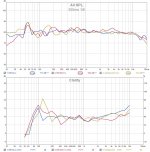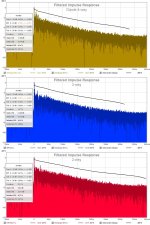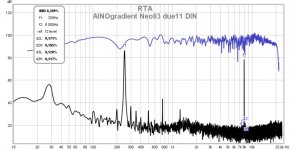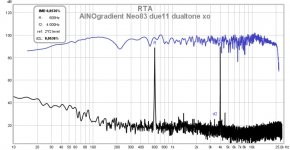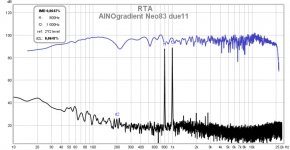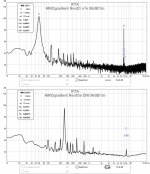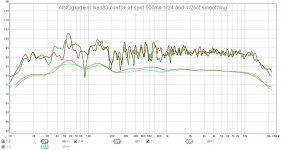Here are my measurements of three different speakers at same location in my living room.
No roomeq applied, but MR18w and AINO use dsp-crossovers. Ainogradient is dipole 4-way, but bass is downfire monople and it makes cardioid pattern between 100-200hz - that explains it's better clarity in that range! IR shows that the dipole speaker gives more reflections around 10-20ms. Dipole speaker has most spl response wiggles in midrange, around Schröder limit. MR18 has also downfire bass, ER18 is on a stand, woofer 80cm above floor.
No roomeq applied, but MR18w and AINO use dsp-crossovers. Ainogradient is dipole 4-way, but bass is downfire monople and it makes cardioid pattern between 100-200hz - that explains it's better clarity in that range! IR shows that the dipole speaker gives more reflections around 10-20ms. Dipole speaker has most spl response wiggles in midrange, around Schröder limit. MR18 has also downfire bass, ER18 is on a stand, woofer 80cm above floor.
Attachments
B&G Neo planar drivers and similar OEM units are still available, but with poor quality assessment.
Info here
Proraum Vertriebs-GmbH | BG-Radia Corp. Information
"From 100 pieces the outcome often was only 30 pieces of really good drivers. This is too delicate without BG, as there defective drivers were replaced.
This method will no longer work, as the new owner is not interested in small OEM customers, and even less in the micro DIY business!
If you order from PE (Parts-Express USA), you get "standard" - from 10 pieces you probably can find 2 to 4 suitable...
Quite frankly, this tolerance problem is prominent with many magnetostats, ribbons and AMT drivers"
Info here
Proraum Vertriebs-GmbH | BG-Radia Corp. Information
"From 100 pieces the outcome often was only 30 pieces of really good drivers. This is too delicate without BG, as there defective drivers were replaced.
This method will no longer work, as the new owner is not interested in small OEM customers, and even less in the micro DIY business!
If you order from PE (Parts-Express USA), you get "standard" - from 10 pieces you probably can find 2 to 4 suitable...
Quite frankly, this tolerance problem is prominent with many magnetostats, ribbons and AMT drivers"
Yes I have spares, Neo8 spares were bought via eBay from Spain some 5 years ago and I bought 4 pc of Neo3 initially.. They all were advertized as being B&G, but came wrapped in plastic and brown cardboard, so who knows their quality. I haven't tested them all, but the Neo3 in my speaker don't match particularly well.
All of mine are PDR versions with cloth "damping" on sides of membrane and without back-cup. When I look at pictures of "clones" I see visual differences in stamping and if this "PDR" cloth is used.
http://www.juoiga.eu/images/datasheets/neo3pdr_white_paper.pdf
https://www.parts-express.com/pedocs/specs/264-712-bohlender-graebener-neo8-specifications-44294.pdf
Spl mismatch is not a problem with dsp, but CSD reveals differencies in short time decay, eg. "ringing" and distortion behaviour - and that cannot be handled with eq.
All of mine are PDR versions with cloth "damping" on sides of membrane and without back-cup. When I look at pictures of "clones" I see visual differences in stamping and if this "PDR" cloth is used.
http://www.juoiga.eu/images/datasheets/neo3pdr_white_paper.pdf
https://www.parts-express.com/pedocs/specs/264-712-bohlender-graebener-neo8-specifications-44294.pdf
Spl mismatch is not a problem with dsp, but CSD reveals differencies in short time decay, eg. "ringing" and distortion behaviour - and that cannot be handled with eq.
Last edited:
A nice story of the Gradient 1.x series of speakers
Gradient 1.3, Gradient 1.2, loudspeaker | Inner Magazines
"Don’t feel embarrassed if, when watching this loudspeaker, you think what you see is a design speaker. It certainly looks as if it were a design speaker, and your belief surely would be justified in view of the fact that the speaker ended up being an item in the MoMA (NY) permanent collection as well as in half a dozen other design venues all over the world. --- The 1.0 – 1.3 have nothing in common with what we commonly understand by a design speaker. It’s born solely out of acoustical concerns, not aesthetic. Every corner and edge are dictated by reason. Every form you can see – round, oval, square, rectangular, pillar – slavishly follow a strictly predetermined function."
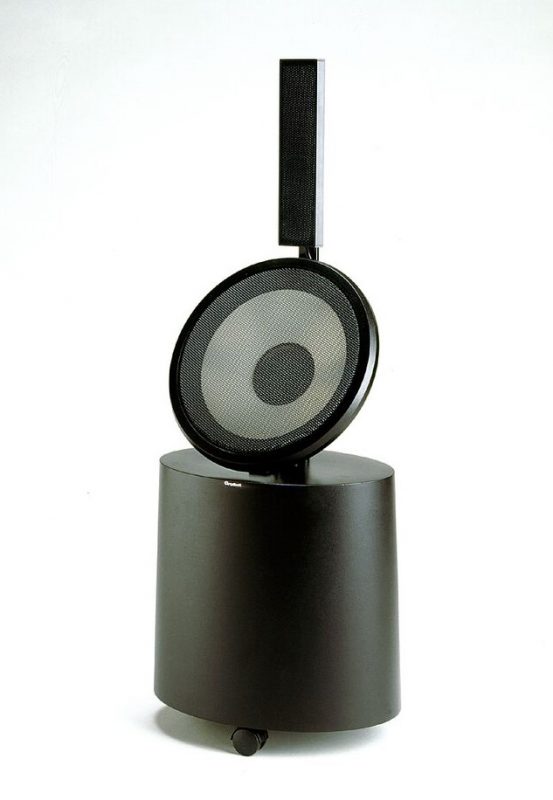
Gradient 1.3, Gradient 1.2, loudspeaker | Inner Magazines
"Don’t feel embarrassed if, when watching this loudspeaker, you think what you see is a design speaker. It certainly looks as if it were a design speaker, and your belief surely would be justified in view of the fact that the speaker ended up being an item in the MoMA (NY) permanent collection as well as in half a dozen other design venues all over the world. --- The 1.0 – 1.3 have nothing in common with what we commonly understand by a design speaker. It’s born solely out of acoustical concerns, not aesthetic. Every corner and edge are dictated by reason. Every form you can see – round, oval, square, rectangular, pillar – slavishly follow a strictly predetermined function."

Last edited:
Last edited:
Dear Juha, this is an interesting project you have here.
How did you arrive at the amount of backward tilt for the 12" low midrange unit? You wrote somewhere in this thread that you get a 10 dB reduction of the floor bounce with a tilt of like 20° (me judging from the pictures).
To maximally reduce the floor bounce, the dipole null should be aligned with the floor reflection. According to that thinking, a driver at 60cm above the floor at 3m distance should be tilted back 68°. That's impractical because of the driver beaming.
As I understand it, the above pictured Gradient 1.3 has a nude 12" with 30° tilt, the Helsinki 1.5 model has 45° with a circular baffle.
Do you have a method to find the best compromise?
Best, Sebastian
How did you arrive at the amount of backward tilt for the 12" low midrange unit? You wrote somewhere in this thread that you get a 10 dB reduction of the floor bounce with a tilt of like 20° (me judging from the pictures).
To maximally reduce the floor bounce, the dipole null should be aligned with the floor reflection. According to that thinking, a driver at 60cm above the floor at 3m distance should be tilted back 68°. That's impractical because of the driver beaming.
As I understand it, the above pictured Gradient 1.3 has a nude 12" with 30° tilt, the Helsinki 1.5 model has 45° with a circular baffle.
Do you have a method to find the best compromise?
Best, Sebastian
Hi Sebastian! I wanted to imitate Gradient 1.3 and tilt comes from there, roughly. And it looks good too! I don't remember if I had the angle specified in my instructions for the professional carpenter. After all, speakers are just bunch of imperfections and compromises!
I haven't done ground plane measurements oudoors, to verify dispersion at angles matching floor reflection. My other measurements tell that a 12" cone as nude dipole seems to null at 80deg, not 90! Anyway, nulling is very difficult to hear in a room, if the ear is more than 20cm from the speaker!
Here an estimate of bounce Floor/Ceiling Reflection Calculator
I haven't done ground plane measurements oudoors, to verify dispersion at angles matching floor reflection. My other measurements tell that a 12" cone as nude dipole seems to null at 80deg, not 90! Anyway, nulling is very difficult to hear in a room, if the ear is more than 20cm from the speaker!
Here an estimate of bounce Floor/Ceiling Reflection Calculator
Attachments
I'm contemplating what to do with my 12" whizzer cone wideband (two whizzers actually - a Fane 12-250TC ->current profile pic), damped in the rear with some woollen rags, crossed over at 350 Hz to a same size bass driver in a damped U-frame. The bass driver is close enough to the floor that there is no discontinuity due to floor reflection within its passband. The main feature is a cardiodid-ish response over the range, although it's a bit more chaotic above 1.5kHz. (Not sure whether this is a liability or an asset!  )
)
I did not know about Gradient and your project when I conceived this, but I found that we have similar goals.
I wonder if crossing over to a 80°x50° CD horn from ~2kHz would be much better. It would match the DI of the wideband, which is about 12dB there. Then, I could tilt back the midrange and suppress floor reflection.
--
Anyone have findings whether floor reflections are actually a bad thing? What has Jorma Salmi found?
In F. Toole's book, he states that he did not investigate it much, quoting Linkwitz and a study from Silzle et al. where floor damping was found to give negative, unnatural impressions.
I did not know about Gradient and your project when I conceived this, but I found that we have similar goals.
I wonder if crossing over to a 80°x50° CD horn from ~2kHz would be much better. It would match the DI of the wideband, which is about 12dB there. Then, I could tilt back the midrange and suppress floor reflection.
--
Anyone have findings whether floor reflections are actually a bad thing? What has Jorma Salmi found?
In F. Toole's book, he states that he did not investigate it much, quoting Linkwitz and a study from Silzle et al. where floor damping was found to give negative, unnatural impressions.
Last edited:
Floor bounce (first null) happens typically below 500Hz, where reverberant sound starts to dominate, masking the null. So I agree with Toole and SL, it is not a significant problem. But it looks terrible in gated measurements!
VituixCAD man kimmosto has several speaker projects with cardioid bass and a horn. KS-1804 models use a backside horn to add ambient sound in the room.
DIY Loudspeakers Kimmo Saunisto
VituixCAD man kimmosto has several speaker projects with cardioid bass and a horn. KS-1804 models use a backside horn to add ambient sound in the room.
DIY Loudspeakers Kimmo Saunisto
Last edited:
Thanks Juha, that makes sense to me.
A different opinion from Robert E. Greene's review of the Gradient 1.3
The Gradient 1.3 Revisited
I don't understand this entirely. The floor reflection of a single instrument right in front of me in my room would be quite the same as a from speaker being in that position! What multi-miked recordings in large venues do to the sound at home is yet another matter.
Anyway, thanks for the feedback, I will look further into improving my setup. BTW, I'm using VituixCAD as well.
A different opinion from Robert E. Greene's review of the Gradient 1.3
The Gradient 1.3 Revisited
Ah, but you say, almost everything we hear has a floor reflection; we're used to it. True, but the real, original floor reflections are already recorded. Moreover, the floor reflections from a cello, say, on stage for you listening in the audience are entirely different from the floor reflections from your speakers eight feet away in your listening room. Speakers with strong floor reflections will always be offering aural clues that you are hearing speakers, not hearing the original music.
I don't understand this entirely. The floor reflection of a single instrument right in front of me in my room would be quite the same as a from speaker being in that position! What multi-miked recordings in large venues do to the sound at home is yet another matter.
Anyway, thanks for the feedback, I will look further into improving my setup. BTW, I'm using VituixCAD as well.
Juha, regarding the mounting of the upper range drivers on the subwoofer box in your system: Do you ever get the feeling the bass vibrations have a negative effect on the clarity of the system? Have you ever experimented with decoupling the 2 parts? Linkwitz was so concerned about it that in the LX521, he physically separated the bass box from rest of the system. When you met him, was this a point of any discussion -- your Aino gradient setup vs his LX521? I ask because there's no doubt the vibrations from the bass driver can be easily felt in the main baffle of upper range drivers in any of the speaker systems I've built, including Linkwitz Orions -- which did decouple the mid driver from the front baffle but the mounting bracket was still attached to the bass box. Surely there's some level of IM distortion that results...?
i´d say that box is stiff and heavy enough to Juha´s listening levels. Dead vibrations
LX521 has flimsy frames, double cone area and that needs 4 time the power to get same output. Would not compare these two.
https://www.diyaudio.com/forums/mul...aborative-speaker-project-17.html#post3494353
LX521 has flimsy frames, double cone area and that needs 4 time the power to get same output. Would not compare these two.
https://www.diyaudio.com/forums/mul...aborative-speaker-project-17.html#post3494353
Last edited:
Yes, manninen knows because he has seen,heard and hugged AINOs!
The woofer is downfire, moves up/down and speaker weight is 42kg. No movement with max spl! The 12" lower mid has felt pads between the pole and vibrates a little by itsef and pole has some resonances. I can't see anything strange in measurements or sound.
Dualtones and SMPTE from 2016. Spl was quite high, problems shoud be visible. A 2-way I measured in similar way showed more IMD.
The woofer is downfire, moves up/down and speaker weight is 42kg. No movement with max spl! The 12" lower mid has felt pads between the pole and vibrates a little by itsef and pole has some resonances. I can't see anything strange in measurements or sound.
Dualtones and SMPTE from 2016. Spl was quite high, problems shoud be visible. A 2-way I measured in similar way showed more IMD.
Attachments
Last edited:
Yes, manninen knows because he has seen,heard and hugged AINOs!
The woofer is downfire, moves up/down and speaker weight is 42kg. No movement with max spl! The 12" lower mid has felt pads between the pole and vibrates a little by itsef and pole has some resonances. I can't see anything strange in measurements or sound.
Dualtones and SMPTE from 2016. Spl was quite high, problems shoud be visible. A 2-way I measured in similar way showed more IMD.
Thanks for the details, Juha.
That 42kg mass probably is a big factor. Ditto manninen's comments re - dual drivers + 4x force for same output as sealed box.
I haven't weighed the M-frame dual-10" Dayton subwoofer bass box (LX521 clone) I'm playing with right now. Each driver weighs 18 lbs, the box is 18mm BB, solidly built; guesstimate 60~70 lbs max. I can definitely feel lots of vibration on the top panel of the M-frame when there's significant bass. It seems unwise to mount the upper range driver baffle directly on top.
I wonder if a slot-loaded W-frame or Linkwitz W-frame (as used in the last versions of the Orion and also by Gainphile in his S19 speakers) has enough force cancellation to make this a non-concern. Hmmm.... I should ask Gainphile!
Ah, when I met SL in 2013, he naturally encouraged me to do dipole woofers too! LX521 was new then and I also knew of gainphile's work. I said no thanks, I don't have enough room for dipole woofers. And I haven't changed my mind. As well I have a huch that real radiation pattern wouldn't be dipole anyway, 20-200Hz so close to the floor and walls. Wuold that really be any better? I guess I'll never really know...
A friend has double 12" woofers in H frame like SL Orion. They sound good in his room and he plays louder than I. He has set tile bricks on them and cone movement looks really wild, but they don't vibrate much. W frame with 90deg helps a lot for LX521, but vertical slot would be totally force-cancelling. That's what I would make.
Gainphile: S19 4-Way Dipole Radiator
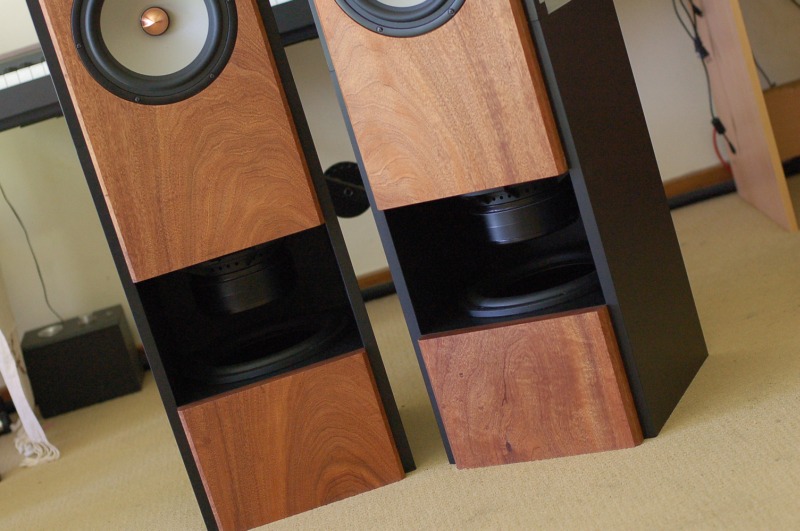
A friend has double 12" woofers in H frame like SL Orion. They sound good in his room and he plays louder than I. He has set tile bricks on them and cone movement looks really wild, but they don't vibrate much. W frame with 90deg helps a lot for LX521, but vertical slot would be totally force-cancelling. That's what I would make.
Gainphile: S19 4-Way Dipole Radiator

Last edited:
I got my UMIK back from the loaner, just had to do some LP response tweaking! See attachment.
Hanski has now two AE 18" IB subwoofers, and we had to tame them a bit below 30Hz. Basically flat response from 5Hz up with extremely low distortion if the mirror is taken down from the wall! Makes me envious...
Hanski has now two AE 18" IB subwoofers, and we had to tame them a bit below 30Hz. Basically flat response from 5Hz up with extremely low distortion if the mirror is taken down from the wall! Makes me envious...
Attachments
How its done? Thru the wall magnets showing up in the kitchen? Ib could be fun on every surface with own 8-10 channel processorHanski has now two AE 18" IB subwoofers
Hanski's vacation house's cellar "hobby room" is the listening room, AE woofers' magnets are in a small storage room. The wall between is gypsum board, wooden frame with some insulation- Some vibration/resonances obviously, but anyway distortion graph doesn't show anytyning strange.
- Home
- Loudspeakers
- Multi-Way
- Aino gradient - a collaborative speaker project
